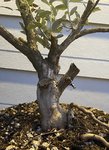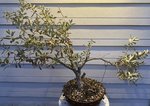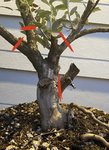Rivka
Shohin
I have a nice midsize olive that i got from a ladies yard last spring.
potted it up with as little disturbance as I could, since she had already ripped it out and unceremoniously dumped it in the street, poor thing
so now 6 months on, it seems content and growing, honestly took the whole move in stride.
So now I would like to cut it back considerably and make plans for it future form also need to plan at some point for a more through repotting down the road.
so:
can i get some clarity on good and bad timing for hard cutbacks? i have searched a good bit here and elsewhere and im getting vague inconsistent info
and anyone care to give input of where you might cut back to if this was yours?


potted it up with as little disturbance as I could, since she had already ripped it out and unceremoniously dumped it in the street, poor thing
so now 6 months on, it seems content and growing, honestly took the whole move in stride.
So now I would like to cut it back considerably and make plans for it future form also need to plan at some point for a more through repotting down the road.
so:
can i get some clarity on good and bad timing for hard cutbacks? i have searched a good bit here and elsewhere and im getting vague inconsistent info
and anyone care to give input of where you might cut back to if this was yours?




